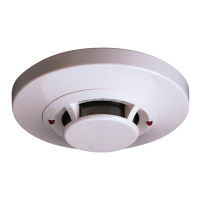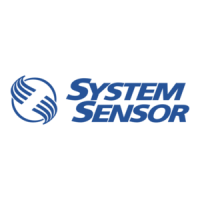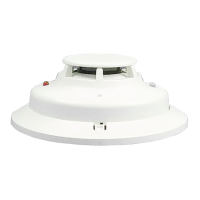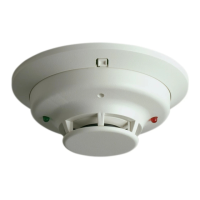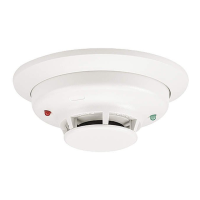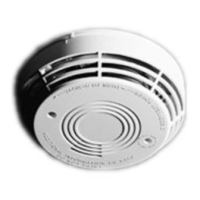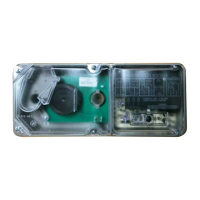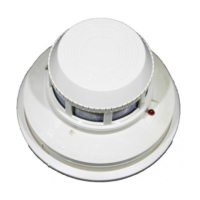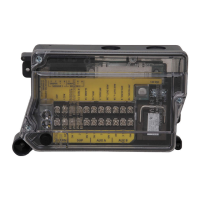Do you have a question about the System Sensor A05-1003-002 and is the answer not in the manual?
NFPA standards for application, installation, and maintenance of automatic smoke detectors.
Regional code organizations influencing smoke detector requirements based on building type and occupancy.
Laboratories testing smoke detectors and control panels for conformance with standards and listing equipment.
How ionization chambers detect smoke particles by monitoring changes in current using radioactive sources.
Key industry publications providing guidance on smoke detectors, particularly in duct applications.
Contacting manufacturers for specific information on their smoke detector products.
Operation of photoelectric detectors using light scattering or obscuration principles to sense smoke.
Factors in smoke detector design focusing on alarm signaling and minimizing unwanted alarms.
Matching detector types (ionization vs. photoelectric) to fire characteristics and building contents for optimal detection.
Discussion of inherent limitations of smoke detectors in providing early fire warning across all scenarios.
Supervising initiating circuits to detect faults, ensuring proper operation and annunciating trouble conditions.
Supervised circuits differentiating short (alarm) and open (trouble) conditions using an end-of-line resistor.
Supervised circuits designed to prevent single opens/grounds from causing loss of system function.
Detectors utilizing internal batteries and wireless transmitters, supervised for tamper and battery status.
Recommendations for system zoning to expedite fire location and simplify troubleshooting processes.
Ancillary equipment control by smoke detectors, including HVAC, door release, and elevator recall functions.
Guidelines for proper smoke detector installation, covering wiring, panel compatibility, and codes.
Illustrating proper and improper wiring methods, focusing on 'T-tapping' and supervision requirements.
Critical placement for effective early warning, covering all accessible areas of the premises.
Testing detector loop wiring for faults and performing system checkout as per manufacturer instructions.
Avoiding placement in environments causing malfunction, such as dusty, humid, or high air movement areas.
Advanced detectors optimized for specific environments like clean rooms or hazardous industrial areas.
UL standards (UL 217, UL 268, UL 268A) and NFPA codes relevant to smoke detector applications.
Guidelines for determining detector spacing based on room dimensions, ceiling height, and coverage area requirements.
Center-to-center spacing based on room size, ceiling height, and obstructions for optimal coverage.
Addressing challenges like uneven ceilings, beams, partitions, and air stratification for proper detector placement.
Using duct detectors in HVAC systems for smoke control and preventing smoke transport.
Placing detectors in plenum spaces in addition to open areas and ducts, not as a substitute.
Mounting detectors below ceiling for better detection in stratified air environments.
Considering HVAC effects on air flow and stratification for proper detector placement.
Placing detectors in air handling spaces, not as a substitute for open area protection.
Influencing detector spacing and protection amount based on burn characteristics and asset value.
Visual inspection, cleaning, and functional testing of detectors to ensure proper operation and sensitivity.
Procedure for handling alarms when no fire exists, including silencing and system reset actions.
Importance of logging all alarms for immediate and long-term analysis of patterns and probable causes.
Common causes of nuisance alarms: improper location, installation, maintenance, and environmental factors.
Reviewing detector placement and environmental factors that may contribute to unwanted alarms.
Checking detectors for dust/dirt and reviewing maintenance schedules to prevent false alarms.
Addressing less common causes like accidental triggering, construction dust, or insect infestation.
Duties of owners and installers in maintaining system integrity, providing training, and record-keeping.
Steps for seeking assistance from installers or manufacturers when alarm causes are undetermined.
NFPA standards for application, installation, and maintenance of automatic smoke detectors.
Regional code organizations influencing smoke detector requirements based on building type and occupancy.
Laboratories testing smoke detectors and control panels for conformance with standards and listing equipment.
How ionization chambers detect smoke particles by monitoring changes in current using radioactive sources.
Key industry publications providing guidance on smoke detectors, particularly in duct applications.
Contacting manufacturers for specific information on their smoke detector products.
Operation of photoelectric detectors using light scattering or obscuration principles to sense smoke.
Factors in smoke detector design focusing on alarm signaling and minimizing unwanted alarms.
Matching detector types (ionization vs. photoelectric) to fire characteristics and building contents for optimal detection.
Discussion of inherent limitations of smoke detectors in providing early fire warning across all scenarios.
Supervising initiating circuits to detect faults, ensuring proper operation and annunciating trouble conditions.
Supervised circuits differentiating short (alarm) and open (trouble) conditions using an end-of-line resistor.
Supervised circuits designed to prevent single opens/grounds from causing loss of system function.
Detectors utilizing internal batteries and wireless transmitters, supervised for tamper and battery status.
Recommendations for system zoning to expedite fire location and simplify troubleshooting processes.
Ancillary equipment control by smoke detectors, including HVAC, door release, and elevator recall functions.
Guidelines for proper smoke detector installation, covering wiring, panel compatibility, and codes.
Illustrating proper and improper wiring methods, focusing on 'T-tapping' and supervision requirements.
Critical placement for effective early warning, covering all accessible areas of the premises.
Testing detector loop wiring for faults and performing system checkout as per manufacturer instructions.
Avoiding placement in environments causing malfunction, such as dusty, humid, or high air movement areas.
Advanced detectors optimized for specific environments like clean rooms or hazardous industrial areas.
UL standards (UL 217, UL 268, UL 268A) and NFPA codes relevant to smoke detector applications.
Guidelines for determining detector spacing based on room dimensions, ceiling height, and coverage area requirements.
Center-to-center spacing based on room size, ceiling height, and obstructions for optimal coverage.
Addressing challenges like uneven ceilings, beams, partitions, and air stratification for proper detector placement.
Using duct detectors in HVAC systems for smoke control and preventing smoke transport.
Placing detectors in plenum spaces in addition to open areas and ducts, not as a substitute.
Mounting detectors below ceiling for better detection in stratified air environments.
Considering HVAC effects on air flow and stratification for proper detector placement.
Placing detectors in air handling spaces, not as a substitute for open area protection.
Influencing detector spacing and protection amount based on burn characteristics and asset value.
Visual inspection, cleaning, and functional testing of detectors to ensure proper operation and sensitivity.
Procedure for handling alarms when no fire exists, including silencing and system reset actions.
Importance of logging all alarms for immediate and long-term analysis of patterns and probable causes.
Common causes of nuisance alarms: improper location, installation, maintenance, and environmental factors.
Reviewing detector placement and environmental factors that may contribute to unwanted alarms.
Checking detectors for dust/dirt and reviewing maintenance schedules to prevent false alarms.
Addressing less common causes like accidental triggering, construction dust, or insect infestation.
Duties of owners and installers in maintaining system integrity, providing training, and record-keeping.
Steps for seeking assistance from installers or manufacturers when alarm causes are undetermined.
| Brand | System Sensor |
|---|---|
| Model | A05-1003-002 |
| Category | Smoke Alarm |
| Language | English |
